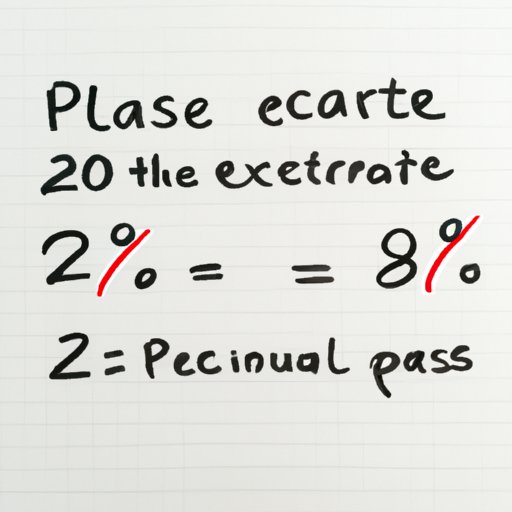
Introduction
Understanding how to calculate a percentage increase is an essential skill for anyone who needs to work with numbers, from students to financial analysts. Knowing how to calculate a percentage increase is important for analyzing data and making informed decisions. This article will provide you with a comprehensive guide to calculating percentage increase, including real-life examples, an infographic, and a video tutorial.
Step-by-Step Guide
The first step in calculating a percentage increase is to know what percentage increase means. A percentage increase measures the increase in a value as a percentage of the original value. To calculate a percentage increase, follow these simple steps:
- Subtract the original value from the new value.
- Divide the result by the original value.
- Multiply the answer by 100 to get the percentage increase.
For example, if you bought a stock for $100 and sold it for $120, the percentage increase would be:
- $120 – $100 = $20
- $20 ÷ $100 = 0.2
- 0.2 x 100 = 20%
So the percentage increase would be 20%.
It’s important to note that the order of the subtraction matters. If you subtract the new value from the original value, the result will be negative. You always want to subtract the original value from the new value to get a positive result.
It’s also important to use the correct formula when calculating percentage increase. Using the wrong formula can result in miscalculations and inaccurate analysis.
Real-Life Examples
Percentage increase calculations are useful in a variety of real-world scenarios. Here are a few examples:
- Salary Increase: If your salary increased from $40,000 to $45,000, what is the percentage increase?
- Sales Increase: A company’s sales went from $100,000 to $150,000. What is the percentage increase?
- Population Increase: A city’s population increased from 50,000 to 75,000. What is the percentage increase?
To calculate the percentage increase for each of these scenarios, follow the step-by-step guide. The percentage increase for the salary increase would be 12.5%, the percentage increase for the sales increase would be 50%, and the percentage increase for the population increase would be 50%.
These examples illustrate how percentage increase calculations can be useful in a variety of situations, from personal finance to business analytics.
Infographic
For a visual representation of how to calculate a percentage increase, check out this infographic:

The infographic simplifies the calculation of percentage increase into clear steps and examples, making it easier to understand. The infographic illustrates how to calculate percentage increase using various scenarios and provides detailed explanations on how to read the infographic.
Video Tutorial
For those who prefer video tutorials, here’s a step-by-step video showing how to calculate a percentage increase in a real-life example:
The video tutorial emphasizes the importance of understanding and using the correct formula and provides an overview of the steps involved in the calculation of percentage increase. Watching the video will help you gain a better understanding of how to calculate percentage increase.
Comparison Chart
A comparison chart can be a useful tool for analyzing financial data. Here’s an example of a comparison chart showing the percentage increase between two products:

The comparison chart illustrates how percentage increase can be used to analyze data and make informed decisions. The key takeaway from this chart is that Product B has a higher percentage increase than Product A.
Common Mistakes
Common mistakes people make when calculating percentage increase include using the wrong formula, using the wrong order of subtraction, and forgetting to multiply the answer by 100 to get the percentage increase. To avoid these common mistakes, always double-check your work and make sure you’re using the correct formula.
Practice Exercises
Practice is key to mastering any skill. Here are a few practice exercises to test your understanding of percentage increase:
- If a car’s value increased from $20,000 to $25,000, what is the percentage increase?
- If a stock’s value increased from $50 to $60, what is the percentage increase?
- If a company’s profits went from $100,000 to $150,000, what is the percentage increase?
Answers: 25%, 20%, 50%.
Conclusion
Calculating percentage increase is an essential skill for understanding and analyzing data. With the step-by-step guide, real-life examples, infographic, video tutorial, comparison chart, and practice exercises provided in this article, you should have a better understanding of how to calculate percentage increase. Remember to double-check your work, use the correct formula, and practice on your own to master this important skill.





